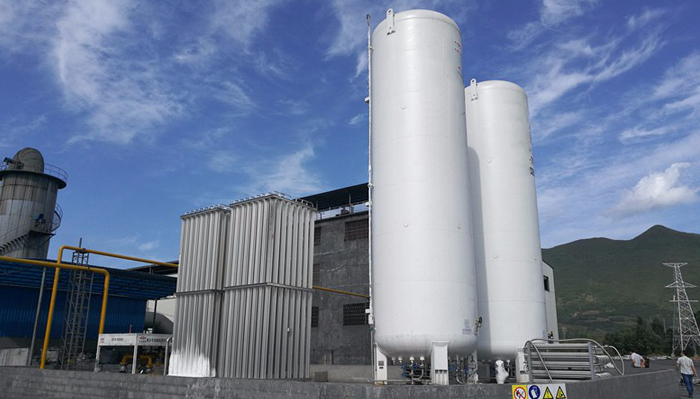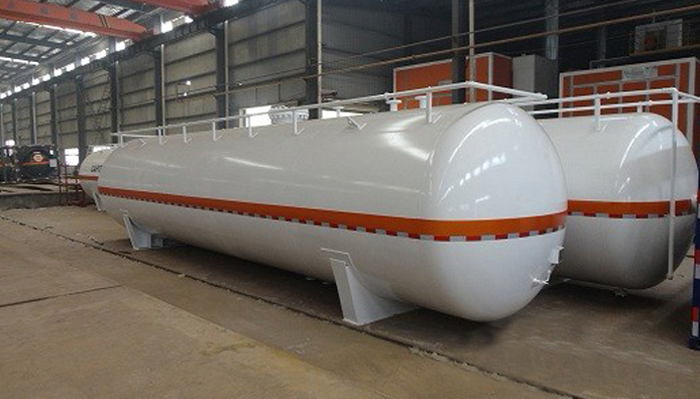Product Category
Introduction to low temperature LNG tank
Date: Nov 18, 2019

Natural gas storage tanks, also known as cryogenic storage tanks, are vertical or horizontal double-layer vacuum insulated storage tanks. The material used for the inner tank is austenitic stainless steel. The outer container material is selected as Q345R according to national regulations. The inner and outer container interlayers are filled with thermal insulation materials. Pearl sand and vacuum. The low-temperature liquid natural gas storage tank products produced by Jianye Company are on-site inspection by the State Bureau of Technical Supervision and issued a pressure vessel supervision and inspection certificate.
Natural gas storage tanks are the main equipment of LNG gasification stations, which directly affect the normal production of gasification stations and also occupy a large proportion of cost. According to the structure, it can be divided into underground storage tanks, above-ground metal storage tanks and metal prestressed concrete storage tanks. For low-temperature LNG storage tanks, it can be divided into vacuum powder insulated storage tanks, positive pressure accumulation insulated storage tanks and high vacuum layer insulated storage tanks, and medium and small gasification stations generally use vacuum powder insulated low temperature storage tanks.
The low-temperature LNG storage tank is divided into two layers, inner and outer layers. The interlayer is filled with pearl sand and vacuumed to reduce the external heat transfer, ensuring that the daily gasification rate of LNG in the tank is less than 0.3%. The operating pressure of the tank is 0.6-1.44 MPa, and the operating temperature is -162 ° C, which is divided into vertical or horizontal.  The LNG tank body consists of two layers inside and outside. In order to reduce the introduction of external heat into the tank, the two layers are vacuum-filled with a thermal insulation structure of the pearl sand cold insulation material, which is isolated from the atmosphere, avoiding the influence of atmospheric pressure or temperature changes and wet. The air enters the cold layer between the inner and outer tanks, which effectively ensures and improves the use of the cold insulation material.
The LNG tank body consists of two layers inside and outside. In order to reduce the introduction of external heat into the tank, the two layers are vacuum-filled with a thermal insulation structure of the pearl sand cold insulation material, which is isolated from the atmosphere, avoiding the influence of atmospheric pressure or temperature changes and wet. The air enters the cold layer between the inner and outer tanks, which effectively ensures and improves the use of the cold insulation material.
LNG storage tanks have high safety requirements. Since the tank stores low-temperature liquid, once the tank is accidentally, the refrigerated liquid will be volatilized in a large amount, and the gasification amount is about 300 times that of the original refrigerating state, and an air mass which will automatically detonate is formed in the atmosphere. Therefore, API, BS and other specifications require the tank to adopt a double-wall structure, using the sealing concept. When the first layer of tank is leaked, the second layer of tank can completely block the leakage liquid and vaporized gas to ensure storage safety.
Natural gas storage tanks are the main equipment of LNG gasification stations, which directly affect the normal production of gasification stations and also occupy a large proportion of cost. According to the structure, it can be divided into underground storage tanks, above-ground metal storage tanks and metal prestressed concrete storage tanks. For low-temperature LNG storage tanks, it can be divided into vacuum powder insulated storage tanks, positive pressure accumulation insulated storage tanks and high vacuum layer insulated storage tanks, and medium and small gasification stations generally use vacuum powder insulated low temperature storage tanks.
The low-temperature LNG storage tank is divided into two layers, inner and outer layers. The interlayer is filled with pearl sand and vacuumed to reduce the external heat transfer, ensuring that the daily gasification rate of LNG in the tank is less than 0.3%. The operating pressure of the tank is 0.6-1.44 MPa, and the operating temperature is -162 ° C, which is divided into vertical or horizontal.

LNG storage tanks have high safety requirements. Since the tank stores low-temperature liquid, once the tank is accidentally, the refrigerated liquid will be volatilized in a large amount, and the gasification amount is about 300 times that of the original refrigerating state, and an air mass which will automatically detonate is formed in the atmosphere. Therefore, API, BS and other specifications require the tank to adopt a double-wall structure, using the sealing concept. When the first layer of tank is leaked, the second layer of tank can completely block the leakage liquid and vaporized gas to ensure storage safety.
Next article:
Send Your Inquiry
We not only provide a good product, but also provide high quality service. If you are interested in our products,
you can contact us in the following ways.
you can contact us in the following ways.







